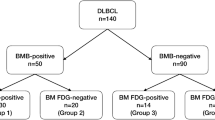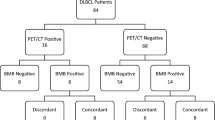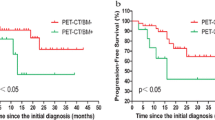Abstract
Purpose
To assess, in patients with diffuse large B-cell lymphoma (DLBCL), whether the low sensitivity of 18F-fluorodeoxyglucose positron emission tomography (FDG-PET) for bone marrow assessment may be explained by histological characteristics of the cellular infiltrate.
Methods
From a prospective cohort of 110 patients with newly diagnosed aggressive lymphoma, 21 patients with DLBCL had bone marrow involvement. Pretherapeutic FDG-PET images were interpreted visually and semiquantitatively, then correlated with the type of cellular infiltrate and known prognostic factors.
Results
Of these 21 patients, 7 (33%) had lymphoid infiltrates with a prominent component of large transformed lymphoid cells (concordant bone marrow involvement, CBMI) and 14 (67%) had lymphoid infiltrates composed of small cells (discordant bone marrow involvement, DBMI). Only 10 patients (48%) had abnormal bone marrow FDG uptake, 6 of the 7 with CBMI and 4 of the 14 with DBMI. Therefore, FDG-PET positivity in the bone marrow was significantly associated with CBMI, while FDG-PET negativity was associated with DBMI (Fisher’s exact test, p=0.024). There were no significant differences in gender, age and overall survival between patients with CBMI and DBMI, while the international prognostic index was significantly higher in patients with CBMI.
Conclusion
Our study suggests that in patients with DLBCL with bone marrow involvement bone marrow FDG uptake depends on two types of infiltrate, comprising small (DBMI) or large (CBMI) cells. This may explain the apparent low sensitivity of FDG-PET previously reported for detecting bone marrow involvement.

Similar content being viewed by others
References
The International Non-Hodgkin’s Lymphoma Prognostic Factors Project. A predictive model for aggressive non-Hodgkin’s lymphoma. N Engl J Med 1993;329:987–94.
Kasamon YL, Wahl RL. FDG PET and risk-adapted therapy in Hodgkin’s and non-Hodgkin’s lymphoma. Curr Opin Oncol 2008;20:206–19.
Kostakoglu L. Early prediction of response to therapy: the clinical implications in Hodgkin’s and non-Hodgkin’s lymphoma. Eur J Nucl Med Mol Imaging 2008;35:1413–20.
Juweid ME, Stroobants S, Hoekstra OS, Mottaghy FM, Dietlein M, Guermazi A, et al. Use of positron emission tomography for response assessment of lymphoma: consensus of the Imaging Subcommittee of International Harmonization Project in Lymphoma. J Clin Oncol 2007;25:571–8.
Cheson BD, Pfistner B, Juweid ME, Gascoyne RD, Specht L, Horning SJ, et al. Revised response criteria for malignant lymphoma. J Clin Oncol 2007;25:579–86.
Moog F, Bangerter M, Kotzerke J, Guhlmann A, Frickhofen N, Reske SN. 18-F-fluorodeoxyglucose-positron emission tomography as a new approach to detect lymphomatous bone marrow. J Clin Oncol 1998;16:603–9.
Moog F, Kotzerke J, Reske SN. FDG PET can replace bone scintigraphy in primary staging of malignant lymphoma. J Nucl Med 1999;40:1407–13.
Even-Sapir E. Imaging of malignant bone involvement by morphologic, scintigraphic, and hybrid modalities. J Nucl Med 2005;46:1356–67.
Fuster D, Chiang S, Andreadis C, Guan L, Zhuang H, Schuster S, et al. Can [18F]fluorodeoxyglucose positron emission tomography imaging complement biopsy results from the iliac crest for the detection of bone marrow involvement in patients with malignant lymphoma? Nucl Med Commun 2006;27:11–5.
Wohrer S, Jaeger U, Kletter K, Becherer A, Hauswirth A, Turetschek K, et al. 18F-fluoro-deoxy-glucose positron emission tomography (18F-FDG-PET) visualizes follicular lymphoma irrespective of grading. Ann Oncol 2006;17:780–4.
Elstrom R, Guan L, Baker G, Nakhoda K, Vergilio JA, Zhuang H, et al. Utility of FDG-PET scanning in lymphoma by WHO classification. Blood 2003;101:3875–6.
Kremer M, Spitzer M, Mandl-Weber S, Stecker K, Schmidt B, Hofler H, et al. Discordant bone marrow involvement in diffuse large B-cell lymphoma: comparative molecular analysis reveals a heterogeneous group of disorders. Lab Invest 2003;83:107–14.
Chung R, Lai R, Wei P, Lee J, Hanson J, Belch AR, et al. Concordant but not discordant bone marrow involvement in diffuse large B-cell lymphoma predicts a poor clinical outcome independent of the International Prognostic Index. Blood 2007;110:1278–82.
Haioun C, Itti E, Rahmouni A, Brice P, Rain JD, Belhadj K, et al. [18F]fluoro-2-deoxy-D-glucose positron emission tomography (FDG-PET) in aggressive lymphoma: an early prognostic tool for predicting patient outcome. Blood 2005;106:1376–81.
Lin C, Itti E, Haioun C, Petegnief Y, Liciani A, Dupuis J, et al. Early 18F-FDG PET for prediction of prognosis in patients with diffuse large B-cell lymphoma: SUV-based assessment versus visual analysis. J Nucl Med 2007;48:1626–32.
Pakos EE, Fotopoulos AD, Ioannidis JP. 18F-FDG PET for evaluation of bone marrow infiltration in staging of lymphoma: a meta-analysis. J Nucl Med 2005;46:958–63.
Meignan M, Haioun C, Itti E, Rahmouni A, Reyes F. Value of [18F]fluorodeoxyglucose-positron emission tomography in managing patients with aggressive non-Hodgkin’s lymphoma. Clin Lymphoma Myeloma 2006;6:306–13.
Ribrag V, Vanel D, Leboulleux S, Lumbroso J, Couanet D, Bonniaud G, et al. Prospective study of bone marrow infiltration in aggressive lymphoma by three independent methods: whole-body MRI, PET/CT and bone marrow biopsy. Eur J Radiol 2008;66:325–31.
Schaefer NG, Strobel K, Taverna C, Hany TF. Bone involvement in patients with lymphoma: the role of FDG-PET/CT. Eur J Nucl Med Mol Imaging 2007;34:60–7.
Pelosi E, Penna D, Deandreis D, Chiappella A, Skanjeti A, Vitolo U, et al. FDG-PET in the detection of bone marrow disease in Hodgkin’s disease and aggressive non Hodgkin’s lymphoma and its impact on clinical management. Q J Nucl Med Mol Imaging 2008;52:9–16.
Campbell J, Seymour JF, Matthews J, Wolf M, Stone J, Juneja S. The prognostic impact of bone marrow involvement in patients with diffuse large cell lymphoma varies according to the degree of infiltration and presence of discordant marrow involvement. Eur J Haematol 2006;76:473–80.
Ghesquieres H, Berger F, Felman P, Callet-Bauchu E, Bryon PA, Traverse-Glehen A, et al. Clinicopathologic characteristics and outcome of diffuse large B-cell lymphomas presenting with an associated low-grade component at diagnosis. J Clin Oncol 2006;24:5234–41.
Acknowledgment
This study was supported by a grant from the French Ministry of Health (PHRC AOM00152).
Author information
Authors and Affiliations
Corresponding author
Rights and permissions
About this article
Cite this article
Paone, G., Itti, E., Haioun, C. et al. Bone marrow involvement in diffuse large B-cell lymphoma: correlation between FDG-PET uptake and type of cellular infiltrate. Eur J Nucl Med Mol Imaging 36, 745–750 (2009). https://doi.org/10.1007/s00259-008-1021-9
Received:
Accepted:
Published:
Issue Date:
DOI: https://doi.org/10.1007/s00259-008-1021-9




